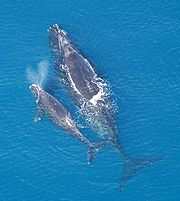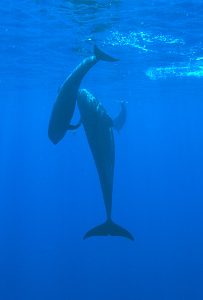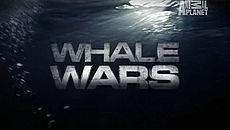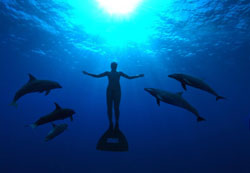Category Archives: Whales & Dolphins
18 baby dolphins found dead in the Gulf of Mexico
On February 21, three baby dolphins were found dead on the shores of Horn Island, and on February 22 the finding of a fourth carcass was confirmed by The Institute for Marine Mammal Studies (IMMS). This brings the amount of dead infant dolphins reported since January up to 18. Since the beginning of the year, 10 adult dolphins have also been found dead.
Located roughly 12 miles (20 km) south of Ocean Springs, Mississippi, Horn Island is one of several islands that make up the Gulf Islands National Seashore Park. National Resource Advisory employees are currently working with BP cleanup crews on the island.
Blair Mase, marine mammal stranding coordinator at The National Oceanic and Atmospheric Administration (NOAA) is concerned about the high number of wash up dead dolphins.
“We’re definitely keeping a close eye on this situation,” says Mase. “We’re comparing this to previous years, trying to find out what’s going on here.”
We are now early in the birthing season for dolphins in the area, and so far, 18 bodies of baby dolphins have been found where the baby was either stillborn or died shortly after birth.
“We’re trying to determine if we do in fact have still births,” says Mase. “There are more in Mississippi than in Alabama and Louisiana. With the oil spill, it is difficult. We’re trying to determine what’s causing this. It could be infectious related. Or it could be non-infection. We run the gamut of causes.”
The necropsy of the dead dolphins will hopefully help shed some light on the situation.
Scientists use sedation to free young entangled Right Whale
Scientists from NOAA and its state and nonprofit partners have applied at-sea chemical sedation to successfully free a young North Atlantic Right Whale off the coast of Cape Canaveral in Florida, USA.
This is only the second time a free-swimming whale has been successfully sedated to enable disentanglement. The first case also concerned a whale spotted off the coast of Florida and occurred in March 2009.
In the most recent case, a female Right Whale born during the 2008-2009 calving season had roughly 200 feet (60 meters) of rope wrapped through her mouth and around the flippers when an aerial survey team spotted her on December 25. Five days later a disentanglement team from Georgia Department of Natural Resources and Florida Fish and Wildlife Conservation Commission was able to remove about 150 feet (45 meters) of rope from her. Unfortunately, they couldn’t safely get the rest of the rope off her and this is why NOAA decided to sedate her, after having tracked her via satellite tag for half a month to see if the remaining rope would come off on its own.
“Our recent progress with chemical sedation is important because it’s less stressful for the animal, and minimizes the amount of time spent working on these animals while maximizing the effectiveness of disentanglement operations,” says Jamison Smith, Atlantic Large Whale Disentanglement Coordinator for NOAA’s Fisheries Service. “This disentanglement was especially complex, but proved successful due to the detailed planning and collective expertise of the many response partners involved.”
On January 15, researchers deemed that the Right Whale wouldn’t be able to free herself from the remaining 50 feet (15 meters) of rope without assistance. The weather was favorable for a rescue mission and a disentanglement team comprised of scientists from NOAA, Georgia Department of Natural Resources, Florida Fish and Wildlife Conservation Commission, Woods Hole Oceanographic Institution, University of Florida, EcoHealth Alliance , and Coastwise Consulting (was dispatched into the Atlantic. Back on shore, the Provincetown Center for Coastal Studies and the New England Aquarium got ready to provide off-site assistance.
The entangled Right Whale was fitted with a temporary satellite tag that would record her behavior before, during and after sedation. She was then sedated and had ropes as well as mesh material removed from her. The mesh resembled mesh used to catch fish, crabs and lobsters along the Atlantic coast and NOAA’s Fisheries Service is currently examining it in an effort to determine its geographic origin.
Once the whale had been freed from the garbage, the researchers administered a drug that reversed the sedation. The whale also received some antibiotics to threat the wounds caused by the debris. She will now be tracked for up to 30-days through the temporary satellite tag.
If you see an entangled or otherwise injured whale you are encouraged to report it to the Florida Fish and Wildlife Conservation Commission (1-888-404-FWCC or 1-888-404-3922) or the Georgia Department of Natural Resources (1-800-2-SAVE-ME or 1-800-272-8366).
Minister Raises Alarm Over Armed Whaling Ships
Foreign Minister McCully has raised the alarm to anti-whaling protesters that ships of Japanese origin will be armed to the teeth, and cautions activists to keep an eye out.
UK Seas Getting Too Noisy, Whales Forced to Shout Mating Calls Louder
Researchers who have been studying the whales making their homes in the seas surrounding Britain have discovered that their calls have become ten times louder over the past five decades as they have battled to be heard about the noises accumulating in the seas.
“The rumbling noises emitted by ships and marine installations have similar frequencies to those used by whales,” explained a marine researcher over at the Woods Hole Oceanographic Institution in Massachusetts, Peter Tyack.
“We found that whales are trying to adapt either by emitting much louder noises or by calling at higher frequencies. It’s like they’ve turned from a bass into a tenor.”
Whales are well known for their ability to talk to each other by using low frequency noise.
Sound waves have the ability to travel for hundreds of miles under the water. The lower the frequency the farther the sound wave can travel.
The number of most species of larger whales have diminished to less than five percent of the number they should be at, so this ability to communicate over large distances is paramount to their survival. However, Dr Tyack and other researchers have concerns that the noise pollution we are creating in the oceans is drowning out or canceling out the mating calls of these whales.
“The whales are not just getting louder. Their messages are getting simpler and repeated more often, just like a human forced to shout,” he explained.
“It also means they spend more energy on communicating.”
Beached Dead Whale “Was World’ Oldest”, Came to Rest in Denmark
A whale which perished after being beached in a Danish fjord earlier on in the year is believed to have been between one hundred and thirty and one hundred and forty years old – which makes it one of the oldest known whales to date, officials commented this past Tuesday.
The age of the whale was determined through an analysis of the fin whale’s remains at the Natural History Museum in Copenhagen.
It was initially believed that the whale was between fifteen and twenty years old. However, after having taken a closer look at the amino acids in the eyes of the remains, it has proved to be closer to between one hundred and thirty and one hundred and forty years old, commented Abdi Hedayat, a museum conservator, commented to the local paper Lokal-Bladet Budstikken.
“That makes it the world’s oldest, scientifically described whale,” he commented.
The oldest whale previously on record was a one hundred and sixteen year old fin whale.
The beached whale was sighted this past June at many different locations in western Denmark before becoming stranded in the Vejle Fjord. Many attempts where made to try and save the whale, however they all failed as the whale made its way back to shallower waters.
The whale’s epic struggle attracted the attention of hundreds of people. The whale was not that big, in total some seventeen meters in length, which is seven meters shorter than the biggest fin whale on record.
Hedayat commented that the ancient whale could have possibly been suffering from brittle bones, but that has yet to be confirmed.
New kind of “Balloon Head” Dolphin Found
A new species of dolphin has been discovered with a short, spoon shaped nose, and a high bulbous forehead. This new “balloon head” dolphin has been identified from fossilized remains discovered in the North Sea.
The Platalearostrum hoekmani was given its name after Albert Hoekman, the Dutch fisherman who stumbled across the skull of the creature in 2008.
These newly discovered dolphins can be up to eighteen feet long, and roamed the world’s oceans some two to three million years ago.
The remains of the amazing creature and a model are part of a fascinating display at the Natural History Museum Rotterdam.
Researchers from the museum, Klaas Post and Erwin Kompanie have gone on record in the journal Deinsea as commenting that the North Sea is a very rich source of fossils in recent years, and has become even more prevalent as fishing has become more common there.
The increase in fishing activity has yielded thousand upon thousands of fossils – many which cannot even begun to be classified.
The only thing which is clear at the moment is that the bone discovered by Mr. Hoekman is that the creature belonging to it is within the same family of aquatic animals known as Delphinids – ocean dwelling dolphins which actually encompasses killer and pilot whales as well.
Anything more descriptive than that is somewhat left in the air.
Based on research, and comparisons of similar fossils, scientists still think that the new species discovered is closest to the pilot whale in the spectrum.
Three Fishermen Rescued After Hitting.. Whale?
Here’s something you don’t hear everyday… A father, son and a family friend spent four nerve wracking hours staying afloat in the open ocean off the north-west coast of Australia, after their boat sank from hitting, of all things they could possible hit, a whale.
A spokeswoman with the police has stated that the men were making their way from Port Samson to Geraldton in a 14 meter long boat, about 8 clicks west of the Exmouth peninsula, when they rammed into a whale and began taking on water.
The men, a 47 year old, his son of 22, and a 48 year old friend of the family, did the only thing they could do, make the mayday call, activate their beacon, and dive into the waves.
“They hit something hard, solid, they suspect it’s a whale,” Senior Sergeant of WA Water Police, Greg Trew commented.
“They abandoned ship and were in the water for about four hours.”
The police have stated that there were fortunate to have been wearing their life jackets, as none could be classed as Olympic swimmers.
The men, while dazed from the ordeal, were not suffering any ill effects after having spent four hours bouncing on the waves before being found by an oil tender which was a rescue coordinated by the police and volunteer marine rescue in Exmouth.
“They’re all in good health, they were prepared for it and did everything right,” Sergeant Trew went on to say.
“Horrendous seas out there, it was pretty shocking conditions, 35-knot winds and three to four meter swells, it was pretty nasty. It would have been pretty bloody awful.”
“Whale Wars” Captain Captain Cover Ups, Lies: “Dishonest” and “Morally Bankrupt”
The Sea Shepherd Conservation Society (SSCS), which is known round the globe as the crew from Animal Planet’s “Whale Wars” has gone by many titles, pirates, environmentalists and even eco-terrorists. However, no matter what you may call them, they are now calling one of their own “dishonest” and “morally bankrupt”, and are going as far as to say that they have been involved in conspiracies and cover-ups.
The former captain of Sea Shepherd, Pete Bethune, who hails from New Zealand, has struck out against the motley, yet sometimes dangerous, group of people who consist of weekend warriors, college activists, and even professionals on vacation. They are well known for causing a ruckus for Japanese whalers, in an attempt to save the whales. However, he seems to be targeting Captain Paul Watson, and accuses him of pulling the wool over the public’s eyes on more than one occasion, exaggerate facts and exploits, among other things.
He even went so far as to write an in depth expose on his Facebook page, and then made himself available for a lengthy piece on the site ecorazzi.com. Bethune even goes as far to offer an “online letter of resignation.”
“I am asking that from now on, SSCS determine to act in an honest way with its volunteers, supporters and media,” Bethune writes as a comment on Facebook. “SSCS does not need to lie. Saving whales, dolphins, tuna and sharks are noble causes, and the public will embrace these as worthwhile. The story does not need to be manipulated and changed in order to get public support.”
While this is certainly an interesting turn of events, only time will tell what, if anything, will come of these accusations.
The Black Fish Cut Japanese Nets to Free Dolphins
The Black Fish, a conservation group based in Europe, have claimed that they cut some nets of holding pens in Taiji, and freed number of dolphins which were due to make their way to various aquariums and dolphinariums around the globe.
The group of divers, associated with The Black Fish, made their way stealthily out, depsite the rough waters, and cut open the nets of six pens which housed the dolphins. Lukily, no arrests were reported, so they seem to have gotten away with it.
The fishermen of Taiji are partaking in the yearly dolphin hunt which started the first of Septembet. The poor creatures are either sold off, or butchered for their meat.
Earlier on in the week, the well known activist whose exploits were featured in “The Cove”, Ric O’Barry, has reported that a number of Risso’s dolphins had been slaughtered by the fishermen. The Sea Shepherd Conservation Society just recently documented the slaughter of pilot whales and Risso’s dolphins.
This escapade by the The Black Fish is the first such act performed by the group this year. While it is vandalism, it is all for a good and just cause.
The co-founder of the Wietse ven der Werf had this to say about the matter: “The connection between the dolphin entertainment industry and this annual drive hunt can no longer be denied. To be successful in our campaigns in Europe we need to get to the root of this illegal trade, which is right at Taiji.”
Iceland Puts Over 200 Whales On Ice
Well now, for being a cold country, Iceland could be landing itself in the hot seat.
It has been reported, from various Whale and Dolphin Society sources, that both the Icelandic fin whaling season and the minke whaling season have come to a close last week.
Some 208 whales have been killed off, which is two more than they killed last year.
Of those 208 whales, 148 were fin whales, and 60 were minke whales. These whales are estimated to be put to good use by creating more than 1,900 tonnes of whale products. This estimate comes from the government of Iceland itself.
Even though the popularity of whale meat has dropped off substantially in both Japan and other European whaling nations, the fin whaling industry of Iceland has made a record catch, the biggest haul since 1985, and is leading people to ask the question “just what are they planning to do with all those whale products”?
The Hvalur fin whaling company is trying to get around the fact that there just isn’t any demand for whale meat locally, by trying to peddle their wares in Japan, and is also pushing some new kinds of whale products. They have even proposed using whale oil to fuel whaling vessels!
This leads one to ask themselves.. Why kill all those whales? If nobody is buying, it is such a waste… Sounds like sometime in the near future, Iceland putting all these whales on ice, might just land them in a heap of hot water..







